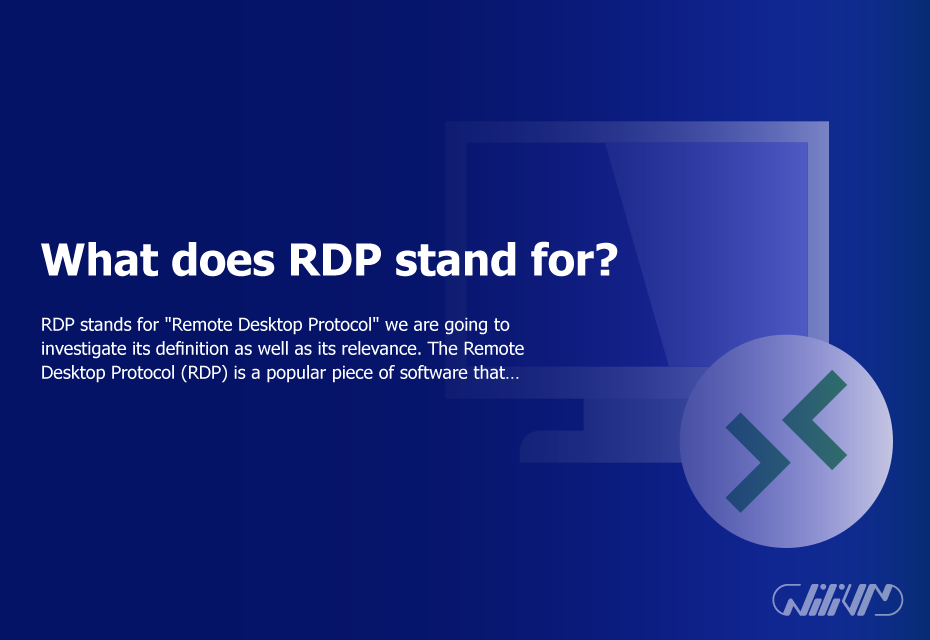What does RDP stand for?
RDP stands for “Remote Desktop Protocol”
we are going to investigate its definition as well as its relevance. The Remote Desktop Protocol (RDP) is a popular software that allows users to remotely access and control another device or computer using a network connection. This article will offer you a full grasp of Remote Desktop Protocol (RDP) and its many facets, regardless of whether you are a novice or an experienced fan of technology.
Contents
Definition of RDP
Microsoft’s RDP stands for Remote Desktop Protocol and is a proprietary protocol. It lets users link their local machine to another remotely, giving them access to and control over that machine’s desktop as if they were sitting at its keyboard. Remote Desktop Protocol (RDP) is a primary tool for remote management, assistance, and teamwork.
Methods of Remote Desktop Protocol
To accomplish its goals, RDP sends GUI data from the distant computer to the client device and then sends back the user’s input to the remote computer. The protocol is implemented over an IP network using the Transmission Control Protocol/Internet Protocol (TCP/IP). To provide a fluid and responsive user experience even on low-bandwidth networks, RDP uses a variety of compression and encoding methods to optimize the delivery of display information.
RDP’s Advantages
Several advantages make RDP a preferred option for remote access. First, it allows users to access their computers or servers remotely, which increases their mobility and efficiency. In addition, RDP enables trouble-free data and asset transfers between local and distant computers, improving teamwork. In addition, RDP’s tight interaction with Windows’ security tools makes for a risk-free remote session.
RDP Applications
The remote desktop protocol has several uses. System administrators use it often because it improves their ability to control and repair distant computers and servers. By allowing technicians to connect to consumers’ computers remotely, RDP is also crucial in the field of remote technical assistance. Additionally, RDP allows workers to access their workplace computers from home, making telecommuting much easier.
Concerns About Safety
There are security concerns that must be addressed while utilizing RDP, despite its usefulness and versatility. Strong passwords, two-factor authentication, and regular system updates and patches may all contribute to RDP’s overall security. Organizations should also think about network-level security measures like deploying VPNs or firewalls to keep RDP traffic safe from prying eyes.
Comparing the Remote Desktop Protocol to Other RATs
There are more remote access protocols out there than RDP. It’s in direct competition with other remote access protocols like VNC, SSH, and TeamViewer. Each protocol has advantages and disadvantages, so picking one is a matter of need. RDP stands out from the crowd because of its flawless compatibility with Windows computers, high performance, and extensive security options.
Common Problems and Solutions
Like any technology, RDP may have bugs that make remote access less than ideal. Issues with network connections and firewall constraints often arise.
issues with compatibility and worries about performance. When troubleshooting RDP, it is important to double-check firewall settings, update client and server software, and maximize network throughput. Problems may be fixed by consulting appropriate documents and asking for help in technical forums.
Prospects for RDP
RDP has advanced in step with the rest of the technological world. The use of remote desktop protocol (RDP) to provide users with virtual desktops is a growing trend in the world of virtual desktop infrastructure (VDI). A second developing pattern is the use of RDP in tandem with cloud computing services, allowing users remote access to and control over cloud-based resources. RDP is anticipated to dramatically improve its capabilities in the future as network speeds and security technologies rapidly advance.
Conclusion
In conclusion, distant desktop protocol (RDP) is a robust piece of software that allows users to connect to and utilize distant computers and devices from any location. In today’s globally networked society, it is an essential tool for facilitating remote administration, assistance, cooperation, and telecommuting. Users may make educated selections and effectively use RDP by being familiar with its description, operating principles, advantages, security issues, and future developments.
FAQs
Can RDP be used over the internet?
Yes, RDP can be used over the internet, but it is essential to implement proper security measures to protect the connection from unauthorized access.
Are there any alternatives to RDP?
Yes, there are other remote access protocols available, such as VNC, SSH, and TeamViewer. The choice depends on specific requirements and preferences.
Can multiple users connect to a remote computer using RDP simultaneously?
In most cases, Windows operating systems allow only one user to connect to a remote computer via RDP at a time. However, Windows Server editions support multiple concurrent connections.
Is RDP suitable for gaming or resource-intensive applications?
While RDP can transmit multimedia content, it may not provide the best experience for gaming or resource-intensive applications due to the inherent latency and limited video acceleration. Specialized remote gaming solutions may offer better performance in such scenarios.







